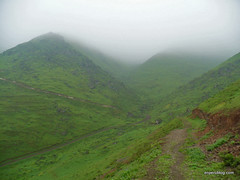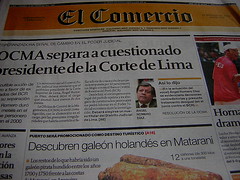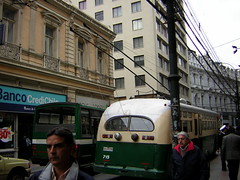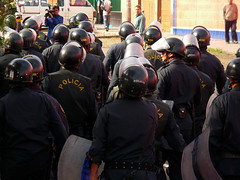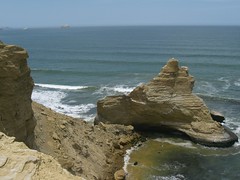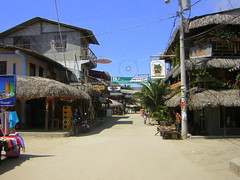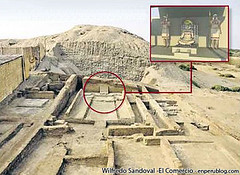Maranga and the Lima Culture
Part of the Lima PreColombina series
In the heart of Pre-Columbian Lima, at the time of the arrival of the Spanish, a vast city was found south of the Rimac River between modern day Lima and Callao. Certainly the administrative centre of power in northern part of the Inca province of Ischma, with Pachacamac an important centre of the south, this city was built long before by the native “Lima Culture” who lived here. Today most of this important complex has been destroyed through the efforts of the Peruvian Government, the University of San Marcos and the Peruvian people in the earlier part of the last century – a time when Peruvians couldn’t care less about their ancient past. Remaining though, and some now finally being restored, are several large huacas, pyramidal mounds, that bare testament to Lima’s long history.
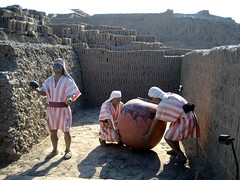 The Lima Culture is the name given to the indigenous people who lived between the Chillón and Lurín valleys, what today is the city of Lima. It is not known what these people called themselves, but the word Lima is thought to come from the word “Limaq” which means To Talk or Talking. Limaq is the word the natives, then ruled by the Incas and speaking Quechua, called the Rimac river. The Spanish kept the name Rimac (L and R being the same in Quechua) to mean the river, which then had the Rimac district named after it, and called their new capital Los Reyes. This didn’t catch on with the natives and people soon started referring to Los Reyes as “Lima”.
The Lima Culture is the name given to the indigenous people who lived between the Chillón and Lurín valleys, what today is the city of Lima. It is not known what these people called themselves, but the word Lima is thought to come from the word “Limaq” which means To Talk or Talking. Limaq is the word the natives, then ruled by the Incas and speaking Quechua, called the Rimac river. The Spanish kept the name Rimac (L and R being the same in Quechua) to mean the river, which then had the Rimac district named after it, and called their new capital Los Reyes. This didn’t catch on with the natives and people soon started referring to Los Reyes as “Lima”.
The Lima culture built their city of Maranga in a fertile inland area not far from the sea, made fertile by a huge channel that brought water here from the river Rimac, one of many that covered the entire area of modern day Lima – engineering works so huge they almost defy belief but have been completely forgotten, but not lost, beneath the city. Maranga consisted of 14 huge pyramids surrounded by at least 50 smaller buildings, spread out over an area of 4,000,000 square metres, making it one of Peru’s largest ancient sites.
But of course, not all was built at once…
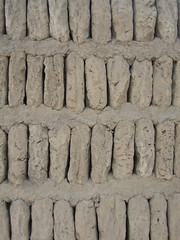 |
200AD to 650AD – The Lima began building their city, their main administrative centre. It was during this time that the main pyramids of Huaca San Marcos, Huaca Concha, Middendorf and Potosi Alto were constructed. These older monumental constructions were built using hundreds of thousands of mud bricks, the same type as you see in the construction of the more easily visited Huaca Pucllana that the Lima built in the same period. Called the “book shelf” style of building, the bricks of the walls appear like books stacked on a shelf. Large numbers of these “books” gradually lean at an angle until they push against others leaning in an opposite angle [||||////\\\\\\||||]- it was in this manner that the Lima’s constructions resisted earthquakes.
650AD to 900AD – The Wari (Huari) civilisation was slowly expanding its territory from their capital near modern-day Ayacucho, forming what was the Andes’ first real empire, and with it more closely related belief systems, language and customs. Wari influence and control swept across the mountains and the coast eventually reaching Lima. The inhabitants here were brought into the fold and the Wari dominated for almost three centuries. Maranga wasn’t abandoned, but it certainly lost its prestige. The Wari much preferred the Lima culture’s southernmost population centre – Pachacamac. The Wari turned the Pachacamac area from a secondary administration centre with a couple of pyramids into the biggest and most important religious centre in the Andean world. It became a huge city, home to thousands and to the Wari’s oracles and priests. Along the Lurín valley, the Lima, who by all means we can now consider to effectively be Wari themselves, built dozens of grand agricultural cities along the valley from Manchay to Sisicaya.
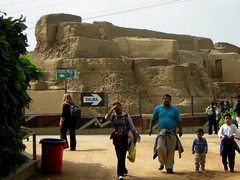 |
900AD to 1450AD – Relics of a by-gone age, the huge Huacas of 200-650AD were little used. After the collapse of the Wari empire, the Lima, ethnically and culturally quite different now, were again fending for themselves. Slightly south of the old Maranga centre, they built the new and quite hi-tech Huaca Tres Palos. On the top of this new truncated pyramid were 96 square holes. In these were placed tree trunks whose falling shadows from the sun and the moon could tell them the exact time of year. From this they could tell when to plant crops or when the tides allowed them to fish. Also built during this time was the Huaca Cruz Blanca, a combined pyramid and an administrative building, with decorated walls demonstrating its importance, below it.
But the most important building built during this time was the Huaca La Palma. At first glance, it looks very similar to the main temple in Pachacamac – and there is a reason for this. Until this huaca was built, the Lima people depended entirely on Pachacamac for all their most important religious activities. So here they decided to build a temple pyramid, smaller but in a similar style to the Pachacamac main temple. Made of two huge “steps”, the pyramid has two ramps that lead up the front to the top, where a room is found that at one time was decorated beautifully. From La Palma the religious order administrated territories around the Rimac River.
1450AD to 1532AD – As the Incas spread creating their empire, they offered the leaders of other civilisations gifts in exchange for joining the empire and retaining some element of power. If these advances were refused, a military conquest would ensue. Pachacamac decided to join the Incas, and the rest of the Lima followed suit. The Lima culture was now part of the Inca Empire, the Tawantinsuyu.
The Lima territory was made an Inca province called Ischma. Spanning from the Chillón valley in the north to the Lurín valley in the south Ischma was itself split into 4 tax divisions, Carabayllo, Maranga, Surco and Pachacamac. In Maranga great changes were taking place as the wealth, power and efficiency of the Inca Empire took hold. The Huaca La Palma became an Inca palace, its walls decorated with Andean Chacanca crosses. To the east, dozens of structures were built by the Incas in what is now called the Inca Sector.
Spanish Conquest – When the Spanish arrived, ending the Inca empire, they founded their capital Los Reyes on the banks of the Rimac river, building on top of the Lima culture constructions that were there, and purposefully destroying those immediately surrounding in Barrios Altos. The Lima people were forced into “Pueblos Indios”, Indian Towns, where they were forced to become Catholic, wear European style clothes and forget their own culture. The city of Maranga, laying well outside the Spanish city walls, was abandoned.
Today – The ruins of Maranga proper are today mostly found in the grounds of the University of San Marcos and the Parque de las Leyendas zoo in San Miguel and Lima Cercado, while the nearby Huaca Mateo Salado complex that was once joined by a walled road is found on the edge of Pueblo Libre and Breña.
It is during the past century, not the Spanish colonial times, that most of the remains of the Lima culture and Maranga have been lost.
The majority of Peruvians during the 20th century not only looked down on the achievements of the indigenous, they considered everything pre-Hispanic to be worthless. The Huaca Pucllana in Miraflores became an place to ride motorbikes, while the Peruvian Government built the Av. Venezuela strain through the southern edge of the Huaca San Marcos.
The biggest loss took place in 1941 when the Huaca Concha was obliterated so that its base could be used for the foundations of a new football stadium. The 3-stepped pyramid was 26 metres high when the Peruvian Government led by Manuel Prado began building the national stadium. Soon after, worked stopped. The Government had changed its mind… and built the new stadium at the old location.
The archaeological zone was then handed to the University of San Marcos, who used it to construct new buildings, destroying the smaller remains around the pyramids. The University decided to continue the construction of the stadium, but once finished found it could never be used – it seems adobe bricks don’t make such a great foundation. In 1992 the remaining parts of the Huaca Concha were destroyed by corrupt president Alberto Fujimori, who was suddenly very eager to complete the stadium. Millions of dollars were spent to dig a few holes and to build some toilets before work was abandoned again.
The other huacas lay heavily damaged, but the buildings that surrounded them for kilometres, and many huacas across modern-Lima, no longer exist. Surviving away from immediate Maranga are the Huacas Mateo Salado, Huaca Pucllana, Huaca Huallamarca and some lesser known such as Huaca San Borja. Here and there a few walls of old buildings survive, sitting uncared for in residential streets and covered in graffiti.
But so much has been lost.
Sadly, things have changed little in Peru. Where once ruins were destroyed for being worthless and in the way, across the country they are now taken advantage of and abused for short term profit. Worse still, is that if a huaca is found in the way of a new project, such as the amplification of the Av. Venezuela outside the San Marcos university in Lima, it still risks being destroyed in the name of “progress”.
Photos
The older pyramids of Maranga (the only parts of the city remaining, residential areas looking this that covered kilometres have long since been built over) are found either side of and along the Avenida Venezuela. The most important structures are walled-off and protected, but others are left uncared for, covered in graffiti and garbage. These unprotected structures are those you will see below, while the newer pyramids of the later period of Maranga’s development sit happily and partially restored within the Parque de las Leyendas Zoo and are not featured here.
Tags: huaca, huari, incas, ischma, leyendas, lima, lima precolombina, maranga, pachacamac, ruins, san marcos



